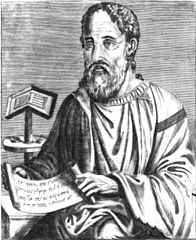
An Ecclesiastical History To The 20th Year Of The Reign Of Constantine by Eusebius
CHAPTER XXXII
THE MARTYRDOM OF SIMEON, BISHOP OF JERUSALEM
AFTER Nero and Domitian, we have also been informed, that in the reign of the emperor whose times we are now recording, there was a partial persecution excited throughout the cities, in consequence of a popular insurrection. In this we have understood, also, that Simeon died as a martyr, who, we have shown, was appointed the second bishop of the church at Jerusalem. To this the same Hegesippus bears testimony, whose words we have already so often quoted. This author, speaking of certain heretics, superadds, that Simeon indeed, about this time having borne the accusation of Christian, although he was tortured for several days, and astonished both the judge and his attendants in the highest degree, terminated his life with sufferings like those of our Lord. But it is best to hear the writer himself, who gives the account as follows: “Of these heretics,” says he, “some reported Simeon the son of Cleophas, as a descendant of David, and a Christian; and thus he suffered as a martyr, when he was a hundred and twenty years old, in the reign of the emperor Trajan, and the presidency of the consular Atticus.” The same author says, “that as search was made for the Jews that were of the tribe of David, his accusers, as if they were descended from this family, were taken in custody.” One might reasonably assert that this Simeon was among the witnesses that bore testimony to what they had both heard and seen of our Lord, if we are to judge by the length of his life, and the fact that the gospels make mention of Mary the daughter of Cleophas, whose son Simeon was, as we have already shown. But the same historian says, that there were others, the offspring of one of those considered brothers of the Lord, whose name was Judas, and that these lived until the same reign after their profession of Christ, and the testimony under Domitian before-mentioned. He writes thus: “There are also those that take the lead of the whole church as martyrs, even the kindred of our Lord; and when profound peace was established throughout the church, they continued to the days of the emperor Trajan, until the time that the above-mentioned Simeon, the relative of our Lord, being the son of Cleophas, was waylaid by the heretics, and also himself accused for the same cause, under Atticus, who was of similar dignity. After he was tormented many days, he died a martyr, with such firmness, that all were amazed, even the president himself, that a man of a hundred and twenty years should bear such tortures. He was at last ordered to be crucified.” The same author, relating the events of the times, also says, that the church continued until then as a pure and uncorrupt virgin; whilst if there were any at all, that attempted to pervert the sound doctrine of the saving gospel, they were yet skulking in dark retreats: but when the sacred choir of apostles became extinct, and the generation of those that had been privileged to hear their inspired wisdom had passed away, then also the combinations of impious error arose by the fraud and delusion of false teachers. These also, as there were none of the apostles left, henceforth attempted, without shame, to preach their false doctrine against the gospel of truth. Such is the statement of Hegesippus. Let us, however, proceed in our history.
Copyright ©1999-2023 Wildfire Fellowship, Inc all rights reserved

 Keep Site Running
Keep Site Running